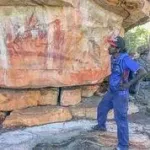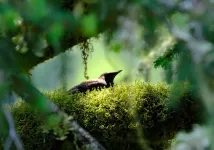Human hiking trails custom built for sauntering grizzlies
Grizzlies take the easy route to save energy
2021-03-31
(Press-News.org) In the run up to hibernation, grizzly bears go on a colossal binge, consuming as many calories as possible to get them through the long winter. Yet, little was known about how much energy the massive mammals use as they shamble around their rugged territories. 'Moving across the landscape in search of food can be a huge energetic expense for some animals', Carnahan says. Fortunately, the Washington State University Bear Research, Education and Conservation Center (WSU BREC), where Carnahan is based, is home to 11 bears, including four that formerly lived in Yellowstone National Park, so he and Charles Robbins (also at WSU BREC) decided to measure the animals' metabolic rates as they sauntered on the flat, and up and down gradients to find out how much energy they use on a daily basis. The team publishes their discovery that grizzly bears prefer to walk on shallow paths to save energy in Journal of Experimental Biology at https://jeb.biologists.com, explaining why the animals often appear on human hiking trails.
'Grizzly bears are amazing animals to work with', says Carnahan. 'As long as you respect what they're capable of, don't surprise them and give them space, they're actually pretty predictable', he explains. Engineers at the WSU BREC constructed a bespoke enclosure from steel and polycarbonate sheets to keep the bears secure while the team measured their oxygen consumption as the animals sauntered on a horse treadmill. Then, the researchers jacked up one end of the treadmill on blocks to simulate the grizzlies ascending and descending a slope. Fortunately, the bears were contented to keep walking, so long as someone continually delivered apple slices to them through a slot in the bear-proof walls. 'The most stressful part of rewarding them was ensuring that the apple slice didn't fall resulting in the bear turning around on the treadmill to go after it', chuckles Carnahan.
After months of patiently measuring the bears' oxygen consumption at speeds ranging from 0.4 to 1.3m/s on the level and gradients up to 20deg to calculate how much energy they used, it was clear that ascending and descending the slopes was quite costly, although the bears used less energy bowling downhill at higher speeds. Most surprisingly, the bears didn't seem to have much spare gas in the tank to maintain long high-speed pursuits. They consume similar amounts of energy to climbing humans, wolves and wild cats, in contrast to fleeing elk and deer, which use 46% less energy than grizzlies over mountainous terrain.
But how did Carnahan and Robbins' energy consumption measurements shape up in comparison with the movements of wild grizzlies in Yellowstone? Collaborating with Frank van Manen and Mark Haroldson from the Interagency Grizzly Bear Study Team, which has been tracking bears since the 1970s, Carnahan analysed 11 years of GPS traces and calculated that wild bears walk at a natural speed of 0.6m/s, similar to that of humans. It also turned out that grizzlies tend to select flatter paths that wind along shallower gradients (no more than 10%) to save energy, instead of tackling steeper ascents and descents. 'The bears did a lot of side-hilling', says Carnahan.
Coincidentally, the bears' preference for shallow gradients is the same as the US National Park service's recommendation for the maximum gradient of trails, which could explain the relatively high number of incidents when backcountry hikers encounter grizzlies. 'Our study helps explain why bears would want to use the same types of terrain as us, so it shouldn't be a surprise to see a bear walking on one of "our" trails', says Carnahan. To stay safe, he advises that hikers chat and make other sounds when out in the woods. 'If a bear can hear you coming, it can make a choice as to how close it wants to be to you. Chances are, you'll never see that bear', says Carnahan.
INFORMATION:
IF REPORTING THIS STORY, PLEASE MENTION JOURNAL OF EXPERIMENTAL BIOLOGY AS THE SOURCE AND, IF REPORTING ONLINE, PLEASE CARRY A LINK TO: https://jeb.biologists.org/content/224/6/jeb241083
REFERENCE: Carnahan, A. M., van Manen, F. T., Haroldson, M. A., Stenhouse, G. B. and Robbins, C. T. (2021). Quantifying energetic costs and defining energy landscapes experienced by grizzly bears. J. Exp. Biol. 224, jeb241083.
DOI: 10.1242/jeb.241083
This article is posted on this site to give advance access to other authorised media who may wish to report on this story. Full attribution is required, and if reporting online a link to jeb.biologists.com is also required. The story posted here is COPYRIGHTED. Therefore advance permission is required before any and every reproduction of each article in full. PLEASE CONTACT permissions@biologists.com
THIS ARTICLE IS EMBARGOED UNTIL TUESDAY, 30 March 2021, 18:00 HRS EDT (23:00 HRS BST)
ELSE PRESS RELEASES FROM THIS DATE:
2021-03-31
New research published in Anaesthesia (a journal of the Association of Anaesthetists) challenges the guidance that special aerosol precautions are only needed when using oxygen therapies for COVID-19 patients, and raises concerns about safety of staff and patients on hospital wards, if they are not protected from infectious aerosols.
The study set out to examine whether oxygen therapies used for patients with severe COVID-19 produce large amounts of small respiratory particles called aerosols, which can transmit virus and can evade routine precautions used on hospital wards. ...
2021-03-31
Rock art of human figures created over thousands of years in Australia's Arnhem Land has been put through a transformative machine learning study to analyse style changes over the years.
The study has tested different styles labelled 'Northern Running figures', 'Dynamic figures', 'Post Dynamic figures' and 'Simple figures with Boomerangs' to understand how these styles relate to one another.
Working with the Mimal and Marrku Traditional Owners of the Wilton River area in Australia's Top End, South Australian researchers led by Flinders University archaeologist Dr Daryl Wesley have taken a closer look at the art of this region.
Flinders researcher Jarrad Kowlessar and the team used machine learning ...
2021-03-31
Highlights
A newly developed tool assesses patients' home dialysis experience.
The 26-item Home Dialysis Care Experience instrument will be a resource for future research use, clinical care, and quality improvement initiatives among home dialysis facilities and organizations.
Washington, DC (March 30, 2021) -- Researchers have developed a new tool to assess patients' opinions and experience concerning home dialysis care. The tool is described in an upcoming issue of CJASN.
Home dialysis, which includes both peritoneal dialysis and home hemodialysis, allows patients to receive their dialysis treatments at home, gives patients independence and flexibility ...
2021-03-30
BOSTON - COVID-19 can have damaging effects on multiple organs in the body, including the brain. A new study led by investigators at Massachusetts General Hospital (MGH) and Beth Israel Deaconess Medical Center (BIDMC) indicates that some hospitalized patients with COVID-19 experience non-convulsive seizures, which may put them at a higher risk of dying. The findings are published in the Annals of Neurology.
"Seizures are a very common complication of severe critical illness. Most of these seizures are not obvious: Unlike seizures that make a person fall down and shake, or convulse, ...
2021-03-30
HOUSTON - (March 30, 2021) - Whether parents prefer a conformance-oriented or independence-oriented supplemental education program for their children depends on political ideology, according to a study of more than 8,500 American parents by a research team from Rice University and the University of Texas at San Antonio.
"Conservative parents have a higher need for structure, which drives their preference for conformance-oriented programs," said study co-author Vikas Mittal, a professor of marketing at Rice's Jones Graduate School of Business. "Many parents ...
2021-03-30
Boulder, Colo., USA: Anthropogenic climate change is one of the foremost scientific and societal challenges. In part, our response to this global challenge requires an enhanced understanding of how the Earth's surface responds to episodes of climatic heating and cooling. As historical records extend back only a few hundred years, we must look back into the ancient rock record to see how the surface of the Earth has responded to shifts between icehouse (presence of ice at the Earth's poles) and greenhouse (no substantial ice at Earth's poles) climates in the past.
In ...
2021-03-30
NEW YORK, NY (March 30, 2021)--Early in the pandemic, neurologists expressed concern that COVID-19 patients with dementia may be at higher risk for complications and mortality.
But those fears have not been realized, according to a new study of patients who were hospitalized with COVID-19 during the first wave of the pandemic in New York City. The study, led by James Noble, MD, MS, associate professor of neurology at Columbia University Vagelos College of Physicians and Surgeons and the Taub Institute for Research on Alzheimer's Disease and the Aging Brain, and Amro Harb, a Vagelos medical student, was published this month in ...
2021-03-30
A year ago scientists everywhere were scrambling to get their minds around the SARS-CoV-2, a novel coronavirus that caused the pandemic from which we are only now beginning to emerge. The world clung to every new development, every bit of science that could provide clues to managing life in the presence of this mysterious killer.
Many science-backed COVID-19 management concepts remain unchanged to this day: handwashing with soap and warm water disrupts the virus' lipid membrane. Social distancing can attenuate the virus's spread, ideally keeping it out of a host until it degrades. Other notions, such as droplet contact being the primary mode of transmission, were modified when emerging evidence showed that under ...
2021-03-30
Not all species may travel the same path to existence, at least according to new findings from the University of Colorado Boulder and collaborators.
This new research, out now in Science, looked at a newly discovered, endangered songbird located only in South America--the Iberá Seedeater--and found that this bird followed a very rare evolutionary path to come into existence at a much faster pace than the grand majority of species.
By comparing this bird to a closely related neighbor (the Tawny-Bellied Seedeater) in the same group (the southern capuchino seedeaters), the researchers determined that genetic shuffling of existing variations, rather than new random mutations, brought this species into existence--and their ...
2021-03-30
CORVALLIS, Ore. - Oregon State University researchers broadcast marbled murrelet calls in mature forests and found that the threatened seabirds' choice of breeding locations is strongly influenced by whether they hear other murrelets in the area.
The research by scientists in the OSU College of Forestry and College of Agricultural Sciences is important because the elusive seabird's populations are in decline and recovery may be hindered by there being too few birds around to provide information to each other about where to nest.
Findings were published in Ornithology, the the flagship journal of the American Ornithologists Union.
"The odds that marbled murrelets would ...
LAST 30 PRESS RELEASES:
[Press-News.org] Human hiking trails custom built for sauntering grizzlies
Grizzlies take the easy route to save energy

